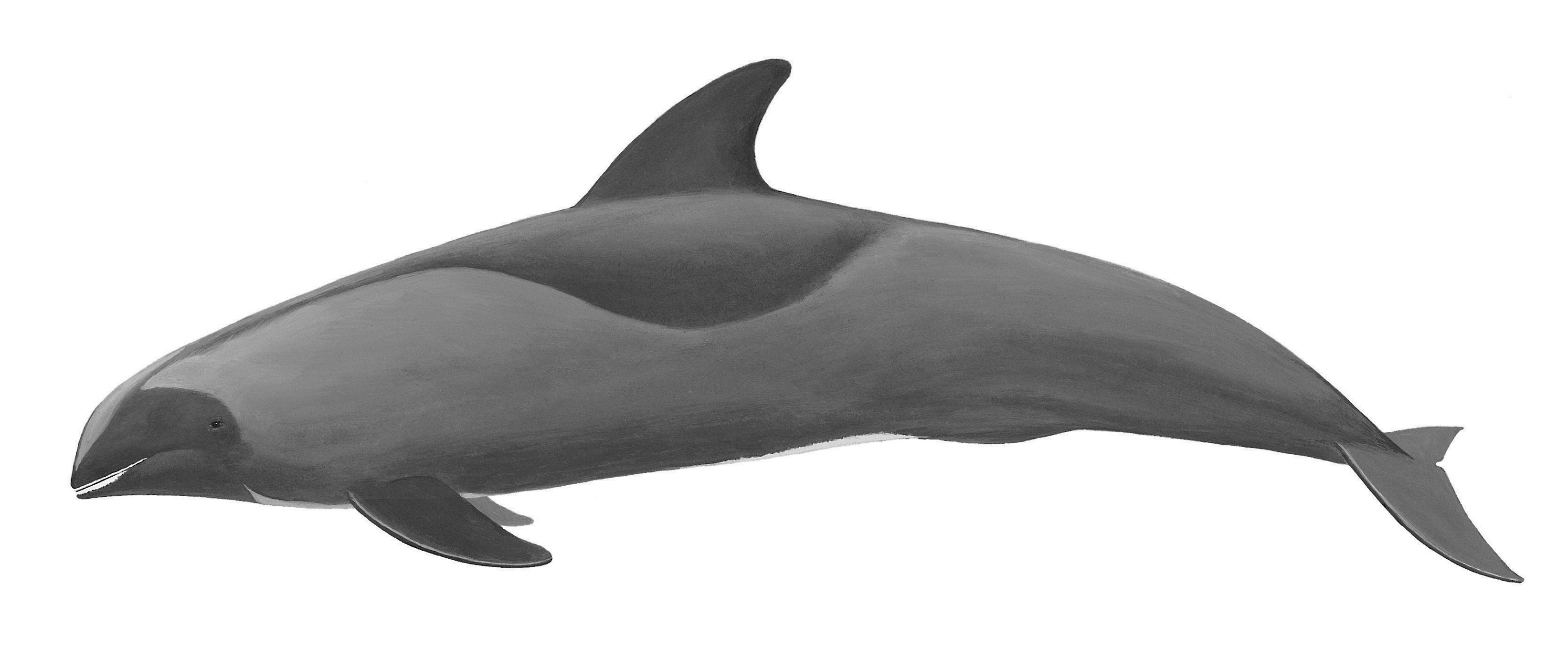MELON-HEADED WHALE
Peponocephala electra (Gray 1846)
Order Cetacea : Family Delphinidae
DESCRIPTION. Melon-headed whales are about the same size as pygmy killer whales (Feresa attenuata), with adult males up to 2.7 m and adult females up to 2.6 m in length. Maximum weight is about 275 kg. The profile of the melon-headed whale may appear similar to that of the pygmy killer whale; however, whereas the pygmy killer whale's head is totally rounded and bulbous, that of the melon-headed whale is rounded in profile and on the top, flat below, and, seen from bottom or top, forms a distinct triangle between the eyes and the tip of the snout. The dorsal fin is distinct and falcate and is located at the middle of the back. The flippers are long and, unlike those of the pygmy killer whale, pointed at the tips. Each upper jaw has 20–25 sharp-pointed teeth, and there are 22–24 teeth in each lower jaw, about twice the number found in the pygmy killer whale and the false killer whale (Pseudorca crassidens). The number of teeth is a firm identification mark for even decomposed animals. Coloration is black except on the belly and around the mouth, with the white lips resembling those of pygmy killer whales. Although the belly may be very white, it is usually a light gray and not as distinct as the white belly patch of the pygmy killer whale.

DISTRIBUTION. Melon-headed whales occur worldwide in tropical and subtropical waters, although they seem to be most numerous in the Philippine Sea. They appear to favor warm, pelagic waters and rarely stray over the continental shelf or near shore. This species was first known in Texas on the basis of two strandings and a sighting at sea.
SUBSPECIES. Monotypic species.
HABITS. Melon-headed whales travel in groups of 100–1,000, although even larger groups have been reported. In the tropical Atlantic, Pacific, and Indian Oceans, they have been reported traveling with Fraser's dolphin (Lagenodelphis hosei) and with spinner and spotted dolphins (Stenella spp.).
Little is known about their reproductive habits. Calving appears to peak in early spring in the low latitudes of both hemispheres. The length of gestation is not known but is probably about 12 months. These whales are not known to migrate, and strandings occur year-round in tropical and subtropical waters. Melon-headed whales feed mainly on squid and fish.
POPULATION STATUS. Common; strandings and observations. The first strandings of the melon-headed whale in the Gulf were of an adult male that stranded alive on west Matagorda Peninsula, Matagorda County, on 22 June 1990; a male that stranded 14 June 1991 in Cameron Parish, Louisiana, near the Texas coast; and a young male that stranded alive south of Corpus Christi in the late summer of 1998. There were 15 confirmed sightings during the GulfCet surveys, including one off the coast of South Texas. Group sizes ranged from 30 to 400 animals, and abundance in the northwestern Gulf has been estimated at about 2,000 animals. This is a deepwater species that rarely strays into the relatively shallow depths over the continental shelf, which accounts for the rarity of strandings. Interestingly, in the most recent stranding period (2002–2014), 14 melon-headed whales stranded along the Texas coast in seven different counties.
CONSERVATION STATUS. These small whales are not listed on the USFWS or TPWD lists of concerned species. The IUCN status of the melon-headed whale is listed as least concern because of the combination of high global abundance and a large pantropical range. There is no reason to believe that it is in any kind of conservation trouble at the present time.
From The Mammals of Texas, Seventh Edition by David J. Schmidly and Robert D. Bradley, copyright © 1994, 2004, 2016. Courtesy of the University of Texas Press.
Natural Science Research Laboratory
-
Address
Museum of Texas Tech University, 3301 4th street, Lubbock, TX 79409 -
Phone
806.742.2486 -
Email
nsrl.museum@ttu.edu

